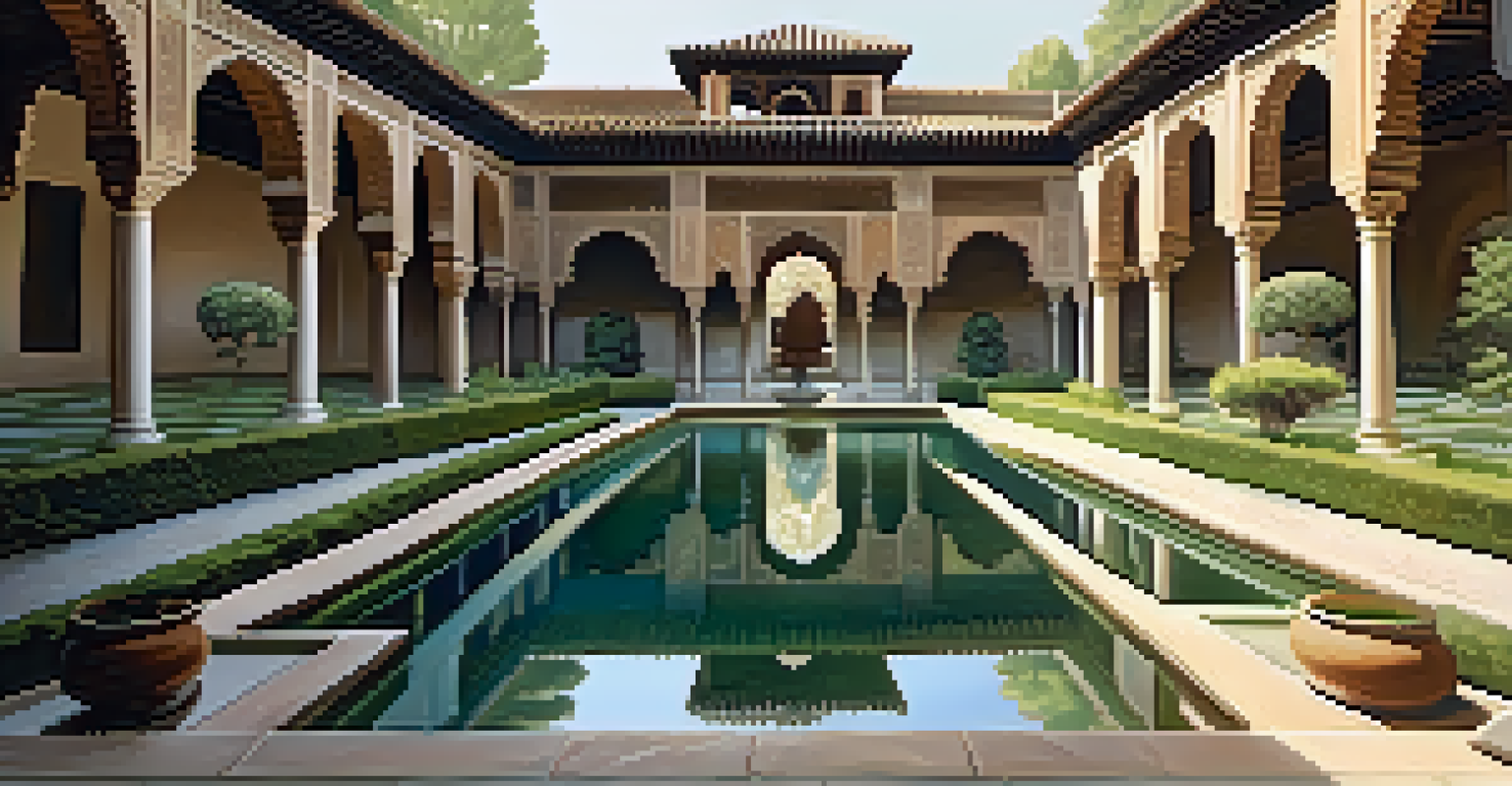The Moorish Influence: Alhambra and Its Architectural Wonders

The Historical Significance of Alhambra
The Alhambra, a UNESCO World Heritage site, is a stunning palace and fortress complex located in Granada, Spain. Its construction began in 1238 during the Nasrid Dynasty and represents the pinnacle of Moorish architecture. This site not only served as a royal residence but also as a hub of culture, art, and learning, deeply influencing the region's history.
Architecture is the learned game, correct and magnificent, of forms assembled in the light.
The name 'Alhambra' translates to 'the red one,' likely due to the reddish hue of its walls at sunset. It stands as a testament to the Islamic Golden Age, showcasing the artistic and scientific advancements of the time. As we explore its architecture, we uncover layers of history that tell the story of coexistence and cultural exchange in medieval Spain.
Today, the Alhambra continues to attract millions of visitors each year, drawn by its magnificent beauty and historical depth. It serves as a reminder of a time when different cultures flourished together, making it a vital piece of Spain's heritage.
Key Architectural Features of the Alhambra
The Alhambra is renowned for its intricate architectural details that merge functionality with beauty. Key features include horseshoe arches, ornate tile work, and elaborate stucco carvings that create a sense of harmony and tranquility. These elements reflect the Islamic principles of design, emphasizing geometric patterns and symmetry.

One of the most impressive aspects is the use of light and water, which are skillfully integrated into the design. The reflecting pools and fountains not only serve practical purposes but also enhance the aesthetic experience, creating a serene atmosphere. This interplay between light and water is a hallmark of Moorish architecture.
Alhambra: A Cultural Heritage Gem
The Alhambra is a UNESCO World Heritage site that showcases the rich cultural exchange between different civilizations in medieval Spain.
Additionally, the vibrant colors of the tiles and mosaics add a lively contrast to the soft hues of the walls. Each detail, from the smallest tile to the grandest arch, contributes to the overall splendor of the complex, making it a visual feast for anyone who visits.
The Influence of Islamic Design Principles
Moorish architecture is characterized by its adherence to specific design principles that prioritize harmony and balance. The Alhambra embodies these principles, showcasing the intricate interplay of light, texture, and space. This architectural style often incorporates natural elements, reflecting the Islamic belief in the beauty of nature.
The great thing about the Alhambra is that it is not only a monument but a living symbol of the cultural interactions of its time.
One notable principle is the use of calligraphy and geometric patterns, which serve both decorative and spiritual purposes. These designs are not merely ornamental; they convey deeper meanings and invite contemplation. In the Alhambra, this is evident in the famous 'Alhambra tiles' that feature complex geometric designs.
Furthermore, the integration of gardens within the architectural layout illustrates the importance of nature in Moorish culture. The Generalife, a summer palace adjacent to the Alhambra, is a prime example of how Islamic design principles create a seamless connection between the built environment and the natural world.
The Alhambra's Cultural Context and Legacy
The Alhambra's architecture is not just a reflection of Moorish aesthetics; it is also a product of its cultural context. During the time of its construction, Spain was a melting pot of different cultures, including Jewish, Christian, and Muslim influences. This rich tapestry of cultural interactions is evident in the architectural styles and motifs found throughout the Alhambra.
As the last stronghold of Muslim rule in Spain, the Alhambra symbolizes the end of an era marked by artistic and intellectual flourishing. After the Reconquista in 1492, the site underwent significant changes as it was adapted for Christian use. Despite these alterations, the Alhambra remains a powerful symbol of cultural resilience.
Moorish Design Principles Shine
Its intricate architectural features and harmonious integration of light and water exemplify the beauty and functionality of Moorish design.
Today, the Alhambra continues to inspire architects and artists worldwide, serving as a benchmark for the integration of art and architecture. Its legacy is a reminder of the beauty that can arise from cultural exchange and collaboration, encouraging future generations to appreciate and preserve this rich history.
Visiting the Alhambra: A Journey Through Time
Visiting the Alhambra is like stepping back in time, offering a unique opportunity to experience history firsthand. As you wander through its expansive gardens and ornate halls, you can almost hear the whispers of the past. Each corner reveals a story, from the grandiose throne room to the tranquil courtyard of the Nasrid Palaces.
Guided tours provide insights into the significance of various architectural features, enhancing your understanding of the site. You’ll learn about the historical figures who once walked these halls and the events that shaped the Alhambra’s legacy. This immersive experience makes it easy to appreciate the craftsmanship and artistry that went into its creation.
Additionally, the breathtaking views of the Sierra Nevada mountains in the backdrop create a picturesque setting, further enriching your visit. The Alhambra is not just an architectural wonder; it is an experience that captures the essence of a bygone era, leaving visitors with lasting memories.
Alhambra’s Role in Modern Architecture
The influence of the Alhambra extends far beyond its historical context, shaping modern architecture in various ways. Architects today draw inspiration from its design principles, particularly in creating spaces that foster harmony and connection with nature. The use of natural materials and open layouts reflects the Alhambra's enduring legacy in contemporary designs.
Moreover, the intricate geometric patterns and decorative elements found in the Alhambra have made their way into modern interiors and urban planning. These design features serve to enhance aesthetics while also encouraging a sense of community and shared space. This blend of tradition and innovation highlights the timeless appeal of Moorish architecture.
Preservation for Future Generations
Ongoing preservation efforts are vital to maintaining the Alhambra's historical value and cultural significance for future visitors.
Incorporating elements inspired by the Alhambra can be seen in various structures around the world, from cultural centers to residential homes. This ongoing dialogue between the past and present emphasizes the importance of preserving architectural heritage while adapting it to modern needs.
Preservation Efforts for the Alhambra
Preserving the Alhambra is crucial not only for its historical value but also for its cultural significance. Various organizations and governmental bodies work tirelessly to maintain and restore the complex, ensuring that future generations can appreciate its beauty. These efforts involve meticulous restoration techniques that respect the original materials and craftsmanship.
One of the challenges faced is the impact of tourism, which, while beneficial for the local economy, can wear down the delicate structures. Sustainable tourism practices are being implemented to mitigate these effects, allowing visitors to enjoy the site while protecting its integrity. This balance is essential to preserving the Alhambra for years to come.

Additionally, educational programs and workshops aim to raise awareness about the importance of architectural preservation. By fostering a sense of stewardship among visitors and locals alike, these initiatives help ensure that the Alhambra remains a celebrated symbol of cultural heritage and artistic achievement.